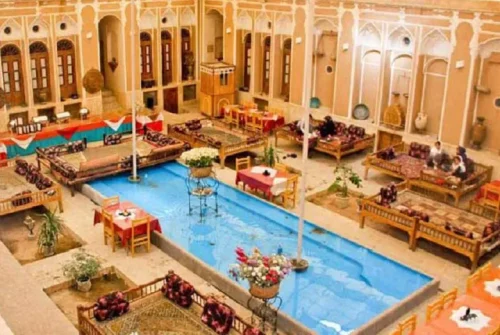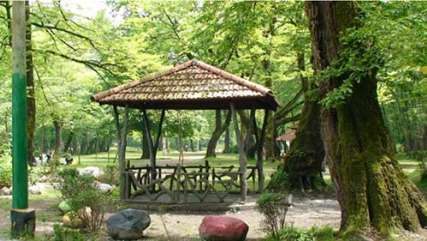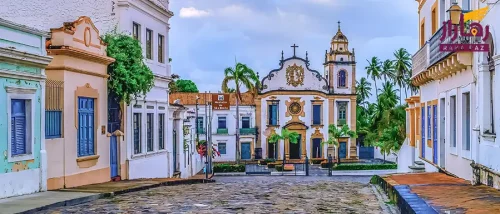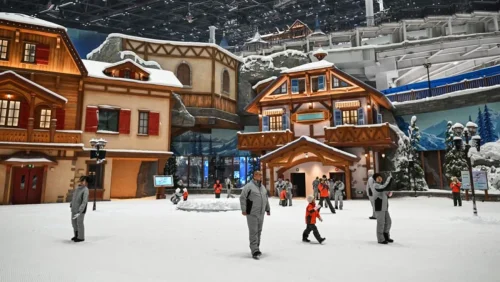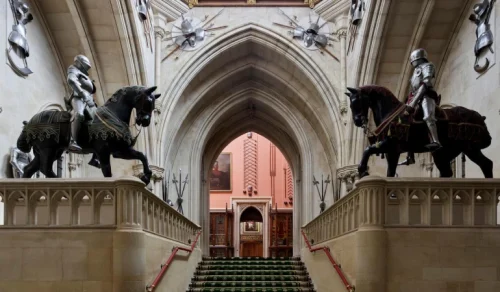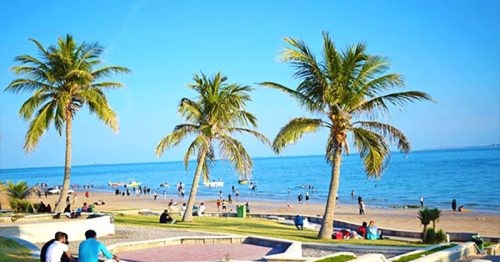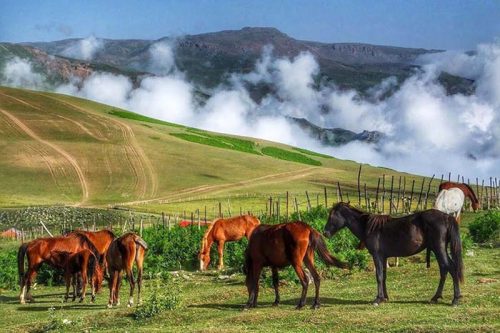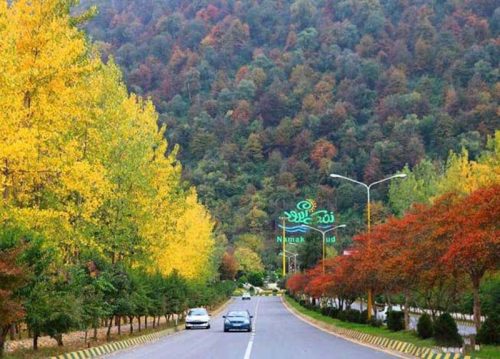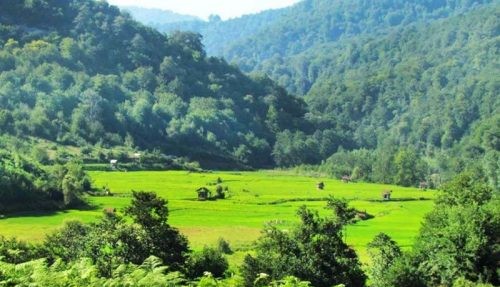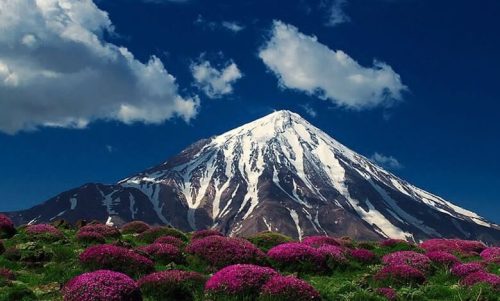Visitor’s Guide to the Chehel Sotoun Palace; Storytelling Columns
Chehel Sotoun Palace, one of the most beautiful and historic buildings in Isfahan, with its unique architecture, hides many stories within. Built during the Safavid era by Shah Abbas I, it was used for hosting foreign guests and ceremonial occasions.
Architecture of Chehel Sotoun Palace
The palace consists of two main sections:
- Main Hall: The hall, adorned with tall, delicate wooden columns and beautiful paintings, creates a majestic and luxurious space.
- Courtyard: The courtyard, with lush gardens and beautiful fountains, offers a relaxing and pleasant atmosphere.
The Columns of Chehel Sotoun Palace
The name of the palace comes from its wooden columns in the main hall. These columns are designed as tall, slender cylinders with intricate wooden and stucco decorations. It is said that they once reflected in the water, giving the illusion of forty columns from afar.
Paintings of Chehel Sotoun Palace
A prominent feature of Chehel Sotoun Palace is its beautiful paintings. These artworks, crafted with natural and delicate colors, depict scenes from the Safavid kings’ lives, court rituals, mythical stories, and the Shahnameh.
Visiting Tips for Chehel Sotoun Palace
- The best time to visit Chehel Sotoun Palace is during spring and autumn.
- You can tour the palace through guided tours or explore it individually.
- Feel free to capture the beauty of Chehel Sotoun Palace with your camera.
- Ensure not to damage the historical artifacts and paintings of the palace.
- Address: Isfahan, Chaharbagh-e-Bala Street, Chehel Sotoun Palace.
Ticket and Tour Reservations
To reserve tickets and tours to Isfahan, you can visit the Irancharter website (Irancharter.ir) or call 02191091190. For more information on Irancharter tours and services, visit Irancharter.ir.
Why Visiting Chehel Sotoun Palace is Essential: Columns that Tell Stories
Chehel Sotoun Palace in Isfahan is one of Iran’s prominent tourist attractions, drawing thousands of domestic and international visitors annually. With its beautiful and historic architecture, this palace is not only a symbol of the Safavid era but also a representation of Iranian art and culture. Visiting this historic site allows you to explore Iran’s rich history and culture while enjoying its architectural beauty. Additionally, the murals and natural attractions surrounding the palace provide visitors with a unique experience.
The History of Chehel Sotoun Palace: Hidden Tales from the Safavid Era
Chehel Sotoun Palace was constructed in the early 17th century by as a reception venue for foreign guests. It is located within Chehel Sotoun Garden, a symbol of Persian garden art. Over time, the palace has witnessed various historical changes and played a significant role in Iran’s architectural and cultural history. Numerous fires in subsequent centuries led to the destruction of some sections, but the palace’s main areas remain preserved in their original style.
Architecture of Chehel Sotoun Palace: A Fusion of Chinese, Iranian, and French Arts
The architecture of Chehel Sotoun Palace is a blend of Chinese, Iranian, and French architectural styles, adding to its beauty and allure. This unique fusion makes Chehel Sotoun one of the world’s architectural masterpieces. The tall wooden columns, spacious verandas, and bas-reliefs on the walls are notable features of the palace. Moreover, the use of mirror work and intricate tile work enhances the interior’s artistic and aesthetic appeal.
How to Access Chehel Sotoun Palace: Different Ways to Reach the Destination
Accessing Chehel Sotoun Palace in Isfahan is quite easy and can be done via various means of transportation. You can use your private car or public transportation like buses and the metro. The closest metro station to Chehel Sotoun Palace is Imam Hossein Station, and a short walk will lead you to your destination. Additionally, bus stops nearby provide quick and convenient access for visitors.
The Best Time to Travel to Isfahan: Optimal Seasons for Visiting Chehel Sotoun Palace
Isfahan is an excellent tourist destination all year round due to its moderate and pleasant climate. However, the best times to visit Chehel Sotoun Palace are in spring and autumn when the weather is favorable, and the gardens are at their best. In spring, Chehel Sotoun is adorned with blossoms, while autumn’s golden leaves add a special charm to the palace. Winters can also be attractive, though some amenities might be limited. Summers, with high temperatures, are ideal for exploring the palace’s shaded areas and gardens.
Tourist Attractions Near Chehel Sotoun Palace in Isfahan
Chehel Sotoun Palace is located near Naqsh-e Jahan Square, another major attraction in Isfahan. Additionally, Sheikh Lotfollah Mosque, Si-o-se-pol Bridge, Vank Cathedral, and Bird Garden are among the nearby sights. Visiting these places allows you to spend a full day exploring Isfahan and enjoying its rich history and culture. Each of these attractions offers its own unique story and features, providing a unique experience for visitors.
Hotels Near Chehel Sotoun Palace: Comfortable Stay Close to Attractions
With a variety of high-quality hotels, Isfahan offers excellent accommodation options for visitors around the Chehel Sotoun Palace. Notable hotels like Sepahan Hotel, Setareh Hotel, Iran Hotel, and Abbasi Hotel are located nearby, offering high standard amenities and easy access to tourist attractions. Choosing the right hotel ensures your comfort and allows you to make the most of your time touring.
Restaurants Near Chehel Sotoun Palace: Experience Local and International Cuisine
Around Chehel Sotoun Palace, there are various restaurants offering local and international cuisines. Restaurants like Goharshad Restaurant, Doran Fast Food, Golestan Briyani, and Sogoli Restaurant are popular choices among visitors. Traditional cafes and teahouses nearby provide a perfect setting for relaxing and enjoying a warm drink or a delicious ice cream. These restaurants offer a diverse menu and pleasant atmosphere, ensuring an enjoyable dining experience during your stroll in Isfahan.
FAQ
- What is Chehel Sotoun and why is it named so?
- Chehel Sotoun is so named because the reflection of its 18 columns in the large pool in front of the palace creates the illusion of 40 columns. This name symbolizes the abundance and grandeur of the palace’s architecture.
- What is the history of the construction of Chehel Sotoun?
- Chehel Sotoun Palace was built during the Safavid era in the 17th century and expanded over time. It was designed as a reception venue for foreign and domestic guests.
- What architectural styles inspired the design of Chehel Sotoun Palace?
- The architecture of Chehel Sotoun Palace is a fusion of Iranian, Chinese, and French styles. This unique combination adds beauty and complexity to the structure of the palace.
- Give details about the murals of Chehel Sotoun Palace.
- The murals of Chehel Sotoun Palace were created by artists of the Safavid era and include miniature paintings with historical and religious themes. These murals were executed using tempera and oil paint techniques.
- Which parts of Chehel Sotoun Palace are accessible to visitors?
- Visitors can explore the grand veranda with its 18 wooden columns, the Hall of Mirrors with beautiful paintings, the Palace, the Upper House, and the Chehel Sotoun Museum.
- What are the working hours and entrance fees for Chehel Sotoun Palace?
- Chehel Sotoun Palace is open daily except for official holidays from 9:30 AM to 3:45 PM. The entrance fee for each Iranian tourist is 50,000 tomans.
- What is the area of Chehel Sotoun and its garden?
- The garden and Chehel Sotoun have an area of about 67,000 square meters. The garden includes a large pool, tall trees, and beautiful green spaces.
- When is the best time to visit Chehel Sotoun Palace?
- The best time to visit Chehel Sotoun Palace is spring, particularly in May, when the garden is fully green. Summer evenings are also suitable due to relatively cooler weather.
- How can I access Chehel Sotoun Palace using public transport?
- To access Chehel Sotoun Palace, you can use Isfahan Metro and disembark at the Imam Hossein Station. A short walk will lead you to the palace entrance.
- On what grounds is Chehel Sotoun designated as a UNESCO World Heritage site?
- Chehel Sotoun is recognized as a UNESCO World Heritage site due to its unique architecture, beautiful murals, and historical significance during the Safavid era.
- What facilities are available near Chehel Sotoun Palace?
- Facilities like the Museum of Contemporary Arts, the Natural History Museum, nearby hotels, and various restaurants are located near Chehel Sotoun Palace, offering diverse services to visitors.
- Is wheelchair accessibility available at Chehel Sotoun Palace?
- There are no facilities like parking in the Chehel Sotoun area, and wheelchair access might be limited. Some historical sections may present challenges for wheelchair use.
- How can one purchase entrance tickets for Chehel Sotoun Palace?
- Entrance tickets to Chehel Sotoun Palace can be purchased on-site at the garden entrance. Some reputable websites also offer online ticket purchases.
- Is photography with flash allowed at Chehel Sotoun Palace?
- No, photography with flash is not allowed at Chehel Sotoun Palace to preserve the murals and artworks. It is recommended to avoid using your camera’s flash while photographing.
- How can a visit to Chehel Sotoun be combined with other attractions in Isfahan?
- Chehel Sotoun can be visited alongside other attractions in Isfahan like Ali Qapu, Si-o-se-pol Bridge, Vank Cathedral, and the Bird Garden for a complete experience of the city’s beauty.
- What are other important tips for visiting Chehel Sotoun Palace?
- While visiting Chehel Sotoun Palace, ensure you spend enough time observing the paintings and architectural details. Note that parking and restroom facilities are not available on-site.

